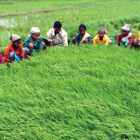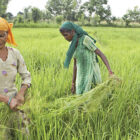Indian agriculture cannot be jump-started without plant variety research, a developed food processing industry, inter-ministerial coordination and favourable trade agreements.
The citrus fruit I grow, a hybrid called Kinnow, originated in California and came to India in 1954 from Lyallpur, now in Pakistan, where it was first planted in 1940. It continues to be the predominant citrus fruit in north India. However, no new citrus variety has caught the farmer’s imagination in over 60 years now, which is a telling commentary about the state of India’s agricultural research. Not easily processed, Kinnow has a limited shelf life and cannot be stored for very long. So when 84,000 hectares of citrus fruit are harvested in the four winter months of India, its market value crashes. Last winter, I received the same price I did back in 2002. Personally distressed, I looked to maize and vegetables.
Today, agriculture diversification is the name of the game and is on the government’s agenda as well. The states, assisted by a central programme, provide subsidised maize seeds to farmers, for example. I grew maize too, hoping to sell at the government-announced Minimum Support Price (MSP) of Rs 1,325 per quintal, I was disappointed. Proclamations and diversification programmes can be misleading. The centre did exactly the same when the UPA was in power: it raised the MSP but initiated no purchases. Of the 25 odd commodities for which it announces an MSP, the government usually initiates bulk purchases for only six. Therefore, I had to sell my maize at Rs 1,215 per quintal directly to a trader, delivered right to his godowns. For a payment by cheque, the trader insisted that I pay a mandi tax. Forcing farmers to pay this tax on his produce even if they do not use the mandi infrastructure is unfair.
At the same time, maize was selling in south India at Rs 1,350 per quintal. I could not realise that higher market value this year. By the next year, hopefully, I will be able to get a better price for my produce, when the National Agriculture Market (NAM)turns operational. The NAM will also allow electronic transactions and a single licence would suffice for all agriculture markets. This is a significant step taken by the government and states like Punjab can either be convinced or coerced to go along with it. In the 2014-15 Economic Survey, India’s Chief Economic Advisor, Arvind Subramanian, issued a veiled warning that went unnoticed. If state governments cannot be persuaded to reorient their respective Agricultural Produce Marketing Committee (APMC) Acts to establish private markets and help develop these in towns to enable farmers to sell their produce directly, said the document, provisions in the Constitution’s List III of the Seventh Schedule (which lists concurrent subjects on which both the Centre and states can legislate) can be used by the centre to enact legislation to that effect.
A national common market for specified farm commodities can be set up under Entry No 33, which covers trade, commerce, production, supply and distribution of food stuffs, including edible oil seeds, oils, raw cotton and jute. Entry No 42 in the union list, which covers interstate trade and commerce, also allows the centre to have a role. The Economic Survey noted that once a law is passed by Parliament to regulate the trade of specified agricultural commodities, it will override the state APMC laws, paving the way for a national common market. It would be ironic if farmers suffering low prices become the nemesis of Prime Minister Narendra Modi in Bihar and derail his ability to enforce or enact this farmer-friendly legislation.
The diversification to fruits and vegetables, though aided by the agriculture ministry, has largely been in accordance with farmers’ response to market demand. Production issues notwithstanding, the marketing of fresh produce has always made for a rollercoaster ride. Take my example. Since it was unviable for me to transport my small quantity of produce to far off Delhi, I would routinely sell my produce in Sri Ganganagar in Rajasthan, the market yard closest to my farm. Farmers all across the country face the same predicament. In a hypothetical world, all small farmers would become part of some sort of a co-operative network, whereby they can sell their output jointly — even to retail chains ready to buy directly from them.
Practically speaking, that is not ever going to happen. Middlemen will always have a place in the system; acting as aggregators as they are businesspersons out to make money. Constant talk of doing away with middlemen is either for public consumption or by those who do not understand farming. What is essential is to moderate their stranglehold on the market by creating competition. To begin with, one could create competition for local middlemen by allowing aggregators from other parts of India to participate in purchases.
To this end, a national common market for fruits and vegetables is a must. APMCs will have to be amended accordingly. Contrary to several voices being heard, public investment will continue to be required in the establishment and maintenance of market yards, as the private sector cannot be expected to fill the gap anytime soon. This is what states are supposed to use mandi tax revenues for: to create and maintain market yards in small towns and villages. Before ridding the system of APMCs (if ever done), an alternative way to fund market yards will be required. It is also of paramount importance to increase points of direct connection between farmers and consumers by facilitating and establishing thousands of farmer markets in urban areas.
Foreign multi-brand retail is often portrayed as something different from Indian multi-brand retail. It is not so. Large scale multi-brand retail chains, whether Indian or foreign, will adopt the same business model to squeeze farmer margins. Large network chains will also become a pipeline to sell imported fruit and products even in the tier II, III and IV cities and towns. No single model can be allowed to overwhelm the whole system and only a combination of different procurement and marketing networks will work to keep each other in check. Some models may work at some place while others might succeed elsewhere. The issue is not about the prevailing law as much as the enforcement of regulations. Because regulators have become facilitators, scepticism is on the rise and the demand for new laws is ironically increasing.
Every farmer will vouch for my personal experience because we are all in the same sinking boat. The difference between the highest price and the lowest price, at which I sold my vegetables this season, was too wide to understand. The price of tomatoes fell from Rs 25 to Rs 2 per kg in three weeks, chillies from Rs 25 to Rs 2 per kg in two-and-a-half months, capsicum from Rs 28 to Rs 6 per kg in five weeks, cucumber halved in 10 days and the price of bottle gourd crashed by 90 per cent within a month. All prices rise on the arrival of rains.
If stock markets underwent such volatility, the government would have to intervene but farmers and consumers in the primary sector suffer such ups and downs every day. For every vegetable’s life cycle, there is a peak harvest time when over half of all farmers’ output in the area matures in the span of the same few weeks, which leads to a crash in farmgate prices. This is preceded and followed by periods of increasing and decreasing harvest quantities. This sharp fall in prices is not reflected in retail prices because middlemen and retailers form a caucus to fleece customers by not reducing prices even if farmers are making distress sales. This is just like textile manufacturers that will not reduce cloth prices even if input cotton prices halve.
India predominantly consumes fresh produce and retail buyers tend to hold, feel and examine the vegetables before making purchases. As it happens, in every harvest, at least 10 per cent of the produce is smaller in size, looks bad and is over or under ripe, which means it will sell at a fraction of the full price even though its nutritional value remains the same. If farmers got reasonable value for this 10 per cent produce then their farm profitability would rise substantially.
For farmers to prosper, the processing of farm produce is a must. This will also mitigate price spikes and inflation in perishable commodities. All varieties of fruits and vegetables, however, cannot be processed. For example, there are over 100 varieties of mango but only a few are good for processing. So it is necessary for public research institutions like the Indian Council of Agriculture Research to bring about better quality planting material for farmers and for industry to process. If that is not available, farmers must be given access to the best planting material in the world. Throwing farmers to unpredictable and volatile international competition without the best planting material and an enabling atmosphere is like putting a goat into a lion’s den.
Even if production hurdles are met, farmers will be hindered by trade arrangements such as those of the Asean, which make it hard for the Indian food processing industry to prosper. India signed the Asean free trade agreement under pressure from the Ministry of External Affairs to counter China’s engagements, even though India had already signed separate agreements with Indonesia, Malaysia and Singapore. Many Asean nations process over two-thirds of their food and cheap imports from there are likely to kill the Indian food processing industry in its nascent stage. In every trade agreement, there are gap years before it becomes operational. The country is supposed to use that period to fund, incentivise and strengthen sectors that will face increased competition from imports, once the treaty is in force. India does not.
In India’s case, after repeatedly being let down by the commerce ministry, the finance ministry could have played a more meaningful role. India’s trade obligations have rendered developing a food processing sector difficult. It is worrisome that Indian negotiators at trade talks are neither trained nor prepared adequately for them but continue to embroil the country in further agreements. The domestic fear of facing trade competition stems equally from the incompetence of Indian policymakers as from subsidies given to farms in countries far away.
Due to a paucity of resources, adequate fund allocation will always be critical to the primary sector’s growth. The centre’s Rs1,700-crore for mega food parks and Rs 50 lakh per unit as a back-ended subsidy for food processing units will not jump start the Indian food processing sector. It is a waste as happened with the SEZs. The tendency is to inflate project cost through bogus bills to garner subsidy payments. Incentives for mega food parks should be based on performance, as with solar electricity power purchase agreements. A five-year income-tax exemption is not something that will draw billions to this sector.
Between multinationals processing agricultural commodities of Indian origin and Indian firms importing food, I would always choose the former. The Food Safety and Standards Authority of India (FSSAI), which has put instant noodles under the scanner, has chosen to turn a blind eye to imported processed food. Most branded juice sold in India, for example, is reconstituted from imported second grade juice concentrate, which would fail tests. In this, it is apparent that the Food Processing Ministry is not in sync with the commerce health and family welfare ministries. Food safety approvals take long and pose a deterrent to large investments. What investors need is a uniform tax structure for processed food products that is compatible with that of countries with which India has signed trade agreements.
It is an uphill task to jump start Indian agriculture in the absence of plant variety research, a developed food processing industry, inter-ministerial coordination and favourable trade agreements. In at least this respect, Modi’s ‘Make in India’ and ‘ease of doing business’ campaigns have a long way to go.




